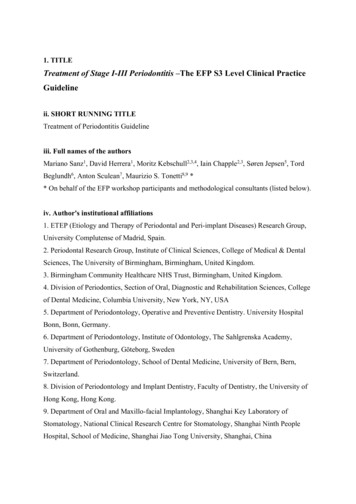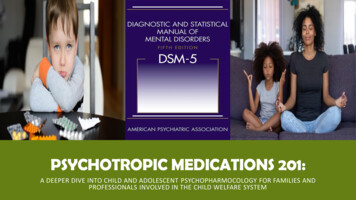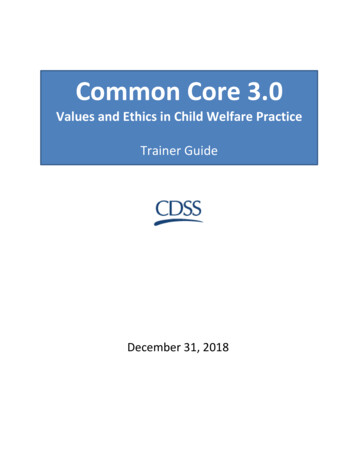
Transcription
The European Welfare State4406G/9710BWinter Term, 2018Professor Bruce MorrisonSSC 4137; x84937; bmorris2@uwo.caOffice hours: Wednesday 2-3, Thursday 10-11, or by appointmentCourse Description:As is perhaps to be expected in the case of a complex political phenomenon subjected tointense politicization, the welfare state has been variously and often erroneouslyinterpreted. It is certainly the case that the conditions that supported the welfare state inearlier decades have weakened, if not dissolved, but the meaning of this remains far fromclear. As we will see, the welfare state was always plural, deriving from a number ofdifferent social, ideological, and institutional sources, and assuming qualitativelydifferent forms in different contexts. There are at least three welfare ‘worlds’ or regimesrather than just one welfare state. However, in the face of powerful changes whichsurfaced during the final third of the twentieth century and have continued into thetwenty-first, the argument has been made in many quarters that the welfare state hasbecome unsustainable or, worse, a hindrance to progress. Evaluating such a claim willdraw us deeply into the following questions. What contribution, if any, did the welfarestate make to the functioning of advanced European economies and polities? Is thewelfare state in Europe on the way out, or are the reports of its death greatly exaggerated?Are the pressures for retrenchment directed at the whole of the welfare state, or just atcertain of its component parts? Should the welfare state be abandoned, either in whole orin part? Are we seeing a process of convergence, according to which the welfare regimetypes will be replaced by a single liberal model? The attempt to treat these questions willalso shed light on such related matters as citizenship, ideology, state formation,partisanship, and economic development.Learning Outcomes:Participants in this seminar will:(a) acquire an understanding of the relationship between the welfare state and the keyelements of modernity;(b) become able to critically assess the case for the existence of three or more welfare regimetypes rather than a singular welfare state, as well as the application of this framework to asignificant number of countries;(c) learn to make sense of and apply the major theories explaining both the emergence andreform of welfare states, and to evaluate the extent to which retrenchment or other formsof change have occurred and may continue to do so.Prerequisites: Political Science 2245E or 2231E.
Requirements and Grading:In addition to keeping up with the weekly readings, you will be required to provide onesubstantial presentation and submit two take-home examinations over the course of theterm. The presentation and the take-home examinations will require some additionalresearch and reading. I will also expect active, informed, and consistent participationfrom the members of the seminar. The breakdown of the grade will be as follows:(a) presentation (15 minutes): 15%;(b) seminar participation: 20%(c) mid-term take-home exam (8-10 pages): 25%(d) final take-home exam (14-16 pages): 40%ReadingsUnit One: Modernity and the Welfare State(January 17, 24)Karl Polanyi, The Great Transformation: The Political and Economic Origins of OurTime (Beacon Press, 1944), pp. 43-102, 135-50.T.H. Marshall, “Citizenship and Social Class,” in Christopher Pierson, Francis G. Castles,and Ingela K. Naumann (eds.), The Welfare State Reader (Polity, 2014).Kathleen Jones, The Making of Social Policy in Britain: From the Poor Law to NewLabour (The Athlone Press, 2000), chapters 1, 2, 5, 6.Christopher Pierson, Beyond the Welfare State? The New Political Economy of Welfare(Polity, 2006), pp. 9-40, 49-62.Unit Two: The Different Welfare WorldsA. Theory(January 31)Gosta Esping-Andersen, The Three Worlds of Welfare Capitalism (Princeton UniversityPress, 1991), chapters 1-3.Philip Manow, “Workers, Farmers and Catholicism: A History of Political ClassCoalitions and the South-European Welfare State Regime.” Journal of European SocialPolicy vol. 25, no. 1 (2015).B. Social Democratic(February 7)
Bo Rothstein, “Labour-Market Institutions and Working-Class Strength,” in SvenSteinmo, Kathleen Thelen, and Frank Longstreth, eds., Historical Institutionalism inComparative Analysis (Cambridge University Press, 1992).Dmitris Tsarouhas, Social Democracy in Sweden: The Threat from a Globalized World(Tauris Academic Studies, 2008), chapter 2.Lars Bo Kaspersen, “The Formation and Development of the Welfare State,” in John L.Campbell, John A. Hall, and Ove K. Pedersen, eds., National Identity and the Varieties ofCapitalism: The Danish Experience (DJOF Publishing, 2006).Jukka Pekkarinen, “Keynesianism and the Scandinavian Models of Economic Policy,” inPeter A. Hall, ed., The Political Power of Economic Ideas: Keynesianism Across Nations(Princeton University Press, 1989).C. Liberal(February 14)Jones, The Making of Social Policy in Britain, chapters 7, 9-12.Theda Skocpol, Social Policy in the United States: Future Possibilities in HistoricalPerspective (Princeton University Press, 1995), chapter 6.Anne Marie Cammisa, From Rhetoric to Reform? Welfare Policy in American Politics(Westview Press, 1998), chapter 2.**Mid-Term Take-Home Exam Due in Class on February 28.D. Conservative Corporatist(February 28, March 7)John S. Ambler, ed., The French Welfare State: Surviving Social and Ideological Change(New York University Press, 1991), chapters 2, 3, and 5.Young-Sun Hong, Welfare, Modernity, and the Weimar State, 1919-1933 (PrincetonUniversity Press, 1998), pp. 16-36.Thomas Paster, “Business and Welfare State Development: Why Did Employers AcceptSocial Reforms?” World Politics vol. 65, no. 3 (July 2013).Isabela Mares, “The Sources of Business Interest in Social Insurance: Sectoral VersusNational Differences.” World Politics vol. 55, no. 2 (January 2003).Unit Three: Reforming the Welfare States?A. Taking Stock, Facing Challenges:(March 14)Kees van Kersbergen and Barbara Vis, Comparative Welfare State Politics:Development, Opportunities, and Reform (Cambridge University Press, 2014), pp. 78102, 123-55.
Jan Zutavern and Martin Kohli, “Needs and Risks in the Welfare State,” in Francis G.Castles, Stephan Leibfried, Jane Lewis, Herbert Obinger, and Christopher Pierson, eds.,The Oxford Handbook of the Welfare State (Oxford University Press, 2010).Volker Meier and Martin Werding, “Ageing and the Welfare State: SecuringSustainability.” Oxford Review of Economic Policy vol. 26, no. 4 (2010), pp. 655-62.Carl-Ulrik Schierup, “Migration, Minorities and Welfare States,” in Christopher Pierson,Francis G. Castles, and Ingela K. Naumann, eds., The Welfare State Reader (Polity,2014).B. Neo-conservatism and the Sources of Social and Institutional Resistance(March 21)Christopher Pierson, Beyond the Welfare State? The New Political Economy of Welfare(Polity, 2006), pp. 41-49.Jones, The Making of Social Policy in Britain, chapters 13-14.Paul Pierson, Dismantling the Welfare State? Reagan, Thatcher, and the Politics ofRetrenchment (Cambridge University Press, 1994), Introduction, chapters 1 and 2.C. Institutional Resistance, Innovation, and Political Competition:(March 28, April 4, 11)i. Vices, Virtues, and Path Dependent Change?Jonah Levy, “Vice into Virtue? Progressive Politics and Welfare Reform in ContinentalEurope.” Politics & Society vol. 27, no. 2 (June 1999).Bruno Palier and Kathleen Thelen, “Institutionalizing Dualism: Complementarities andChange in France and Germany.” Politics and Society vol. 38, no. 1 (2010).Dimitris Tsarouhas, “A New Swedish Model? Swedish Social Democracy at theCrossroads,” in John Callaghan, Nina Fishman, Ben Jackson and Martin McIvor, eds., InSearth of Social Democracy: Responses to Crisis and Modernisation (ManchesterUniversity Press, 2009).Claes Belfrage and Magnus Ryner, “Renegotiating the Swedish Social DemocraticSettlement: From Pension Fund Socialism to Neoliberalization.” Politics and Society vol.37, no. 2 (June 2009).ii. Convergence or Regeneration as a Social Investment State?Kees van Kersbergen and Anton Hemerijck, “Two Decades of Change in Europe: TheEmergence of the Social Investment State.” Journal of Social Policy vol. 41, no. 3(2012).Giuliani Bonoli, “The Political Economy of Active Labour Market Policy.” Politics &Society vol. 38, no. 4 (2010).Bea Cantillon and Wim Van Lancker, “Three Shortcomings of the Social InvestmentPerspective.” Social Policy and Society vol. 12, no. 4 (2013).
Kati Kuitto, “From Social Security to Social Investment? Compensating and SocialInvestment Welfare Policies in a Life-Course Perspective.” Journal of European SocialPolicy vol. 26, no. 5 (2016).iii. Parties, Electoral Competition, and Welfare ReformGus Schumacher, “’Marx’ or the Market? Intra-Party Power and Social DemocraticWelfare State Retrenchment.” West European Politics vol. 35, no. 5 (September 2012).Jane Gingrich and Silja Hausermann, “The Decline of the Working-Class Vote, theReconfiguration of the Welfare Support Coalition and Consequences for the WelfareState.” Journal of European Social Policy vol. 25, no. 1 (2015).Barbara Vis, “Taking Stock of the Comparative Literature on the Role of BlameAvoidance Strategies in Social Policy Reform.” Journal of Comparative Policy Analysisvol. 18, no. 2 (2016).Peter Taylor-Gooby, “The Divisive Welfare State.” Social Policy and Administration vol.50, no. 6 (November 2016).**Final Take-Home Exam Due April 27th at 5 pm.
APPENDIX TO UNDERGRADUATE COURSE OUTLINESDEPARTMENT OF POLITICAL SCIENCEPrerequisite checking - the student’s responsibility"Unless you have either the requisites for this course or written special permission from your Dean to enroll init, you may be removed from this course and it will be deleted from your record. This decision may not beappealed. You will receive no adjustment to your fees in the event that you are dropped from a course forfailing to have the necessary prerequisites."Essay course requirementsWith the exception of 1000-level courses, most courses in the Department of Political Science are essaycourses. Total written assignments (excluding examinations) will be at least 3,000 words in Politics 1020E, atleast 5,000 words in a full course numbered 2000 or above, and at least 2,500 words in a half coursenumbered 2000 or above.Use of Personal Response Systems (“Clickers”)"Personal Response Systems ("clickers") may be used in some classes. If clickers are to be used in a class, it isthe responsibility of the student to ensure that the device is activated and functional. Students must see theirinstructor if they have any concerns about whether the clicker is malfunctioning.Students must use only their own clicker. If clicker records are used to compute a portion of the course grade: the use of somebody else’s clicker in class constitutes a scholastic offence, the possession of a clicker belonging to another student will be interpreted as an attempt to commit ascholastic offence."Security and Confidentiality of Student Work (refer to current Western Academic tting or Returning Student Assignments, Tests and Exams - All student assignments, tests and examswill be handled in a secure and confidential manner. Particularly in this respect, leaving student workunattended in public areas for pickup is not permitted."Duplication of workUndergraduate students who submit similar assignments on closely related topics in two different coursesmust obtain the consent of both instructors prior to the submission of the assignment. If prior approval is notobtained, each instructor reserves the right not to accept the assignment.Grade adjustmentsIn order to ensure that comparable standards are applied in political science courses, the Department mayrequire instructors to adjust final marks to conform to Departmental guidelines.Academic Offences"Scholastic offences are taken seriously and students are directed to read the appropriate policy, specifically,the definition of what constitutes a Scholastic Offence, at the following Web site:http://www.uwo.ca/univsec/pdf/academic policies/appeals/scholastic discipline undergrad.pdf
Submission of Course RequirementsESSAYS, ASSIGNMENTS, TAKE-HOME EXAMS MUST BE SUBMITTED ACCORDING TO PROCEDURES SPECIFIEDBY YOUR INSTRUCTOR (I.E., IN CLASS, DURING OFFICE HOURS, TA'S OFFICE HOURS) OR UNDER THEINSTRUCTOR'S OFFICE DOOR.THE MAIN OFFICE DOES NOT DATE-STAMP OR ACCEPT ANY OF THE ABOVE.Attendance Regulations for ExaminationsEXAMINATIONS/ATTENDANCE (Sen. Min. Feb.4/49, May 23/58, S.94, S.3538, S.3632, S.04-097) A student isentitled to be examined in courses in which registration is maintained, subject to the following limitations: 1) Astudent may be debarred from writing the final examination for failure to maintain satisfactory academicstanding throughout the year. 2) Any student who, in the opinion of the instructor, is absent too frequently fromclass or laboratory periods in any course will be reported to the Dean of the Faculty offering the course (afterdue warning has been given). On the recommendation of the Department concerned, and with the permission ofthe Dean of that Faculty, the student will be debarred from taking the regular examination in the course. TheDean of the Faculty offering the course will communicate that decision to the Dean of the Faculty of registration.Medical Policy, Late Assignments, etc.Students registered in Social Science should refer tohttp://counselling.ssc.uwo.ca/procedures/having problems/index.html for information on Medical Policy,Term Tests, Final Examinations, Late Assignments, Short Absences, Extended Absences, Documentation andother Academic Concerns. Non-Social Science students should refer to their home faculty’s academiccounselling office.University Policy on Cheating and Academic MisconductPlagiarism: Students must write their essays and assignments in their own words. Whenever students takean idea, or a passage from another author, they must acknowledge their debt both by using quotation markswhere appropriate and by proper referencing such as footnotes or citations. Plagiarism is a major academicoffence." (see Scholastic Offence Policy in the Western Academic Calendar).Plagiarism Checking: "All required papers may be subject to submission for textual similarity review to thecommercial plagiarism detection software under license to the University for the detection of plagiarism. Allpapers submitted for such checking will be included as source documents in the reference database for thepurpose of detecting plagiarism of papers subsequently submitted to the system. Use of the service is subjectto the licensing agreement, currently between The University of Western Ontario and Turnitin.com (http://www.turnitin.com )."Multiple-choice tests/exams: "Computer-marked multiple-choice tests and/or exams may be subject tosubmission for similarity review by software that will check for unusual coincidences in answer patterns thatmay indicate cheating."Note: Information excerpted and quoted above are Senate regulations from the Handbook of Scholarship andAcademic Policy. http://www.uwo.ca/univsec/academic policies/index.html
PLAGIARISM*In writing scholarly papers, you must keep firmly in mind the need to avoid plagiarism. Plagiarism isthe unacknowledged borrowing of another writer's words or ideas. Different forms of writing requiredifferent types of acknowledgement. The following rules pertain to the acknowledgements necessary inacademic papers.A.In using another writer's words, you must both place the words in quotation marks and acknowledgethat the words are those of another writer.You are plagiarizing if you use a sequence of words, a sentence or a paragraph taken from otherwriters without acknowledging them to be theirs. Acknowledgement is indicated either by (1) mentioning theauthor and work from which the words are borrowed in the text of your paper; or by (2) placing a footnotenumber at the end of the quotation in your text, and including a correspondingly numbered footnote at thebottom of the page (or in a separate reference section at the end of your essay). This footnote should indicateauthor, title of the work, place and date of publication, and page number.Method (2) given above is usually preferable for academic essays because it provides the reader withmore information about your sources and leaves your text uncluttered with parenthetical and tangentialreferences. In either case words taken from another author must be enclosed in quotation marks or set offfrom your text by single spacing and indentation in such a way that they cannot be mistaken for your ownwords. Note that you cannot avoid indicating quotation simply by changing a word or phrase in a sentence orparagraph which is not your own.B.In adopting other writers' ideas, you must acknowledge that they are theirs.You are plagiarizing if you adopt, summarize, or paraphrase other writers' trains of argument, ideas orsequences of ideas without acknowledging their authorship according to the method of acknowledgementgiven in 'A' above. Since the words are your own, they need not be enclosed in quotation marks. Be certain,however, that the words you use are entirely your own; where you must use words or phrases from yoursource, these should be enclosed in quotation marks, as in 'A' above.Clearly, it is possible for you to formulate arguments or ideas independently of another writer who hasexpounded the same ideas, and whom you have not read. Where you got your ideas is the importantconsideration here. Do not be afraid to present an argument or idea without acknowledgement to anotherwriter, if you have arrived at it entirely independently. Acknowledge it if you have derived it from a sourceoutside your own thinking on the subject.In short, use of acknowledgements and, when necessary, quotation marks is necessary to distinguishclearly between what is yours and what is not. Since the rules have been explained to you, if you fail to makethis distinction your instructor very likely will do so for you, and they will be forced to regard your omission asintentional literary theft. Plagiarism is a serious offence which may result in a student's receiving an 'F' in acourse or, in extreme cases in their suspension from the University.*Reprinted by permission of the Department of HistoryAdopted by the council of the Faculty of Social Science, October, 1970; approved by the Dept. of HistoryAugust 13, 1991
Accessibility at Western: Please contact poliscie@uwo.ca if you require any information in plain text format,or if any other accommodation can make the course material and/or physical space accessible to you.SUPPORT SERVICESThe Registrar’s office can be accessed for Student Support Services at http://www.registrar.uwo.caStudent Support Services (including the services provided by the USC listed here) can be reached at:http://westernusc.ca/services/Student Development Services can be reached at: http://www.sdc.uwo.ca/Students who are in emotional/mental distress should refer to Mental h/ for a complete list of options about how to obtain help.
The French Welfare State: Surviving Social and Ideological Change (New York University Press, 1991), chapters 2, 3, and 5. Young-Sun Hong, Welfare, Modernity, and the Weimar State, 1919-1933 (Princeton University Press, 1998), pp. 16-36. Thomas Paster, "Business and Welfare State Development: Why Did Employers Accept Social Reforms?"










